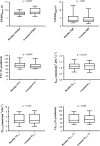Quantification of pulmonary perfusion in idiopathic pulmonary fibrosis with first pass dynamic contrast-enhanced perfusion MRI
- PMID: 33273022
- PMCID: PMC7815896
- DOI: 10.1136/thoraxjnl-2019-214375
Quantification of pulmonary perfusion in idiopathic pulmonary fibrosis with first pass dynamic contrast-enhanced perfusion MRI
Abstract
Introduction: Idiopathic pulmonary fibrosis (IPF) is a fatal disease of lung scarring. Many patients later develop raised pulmonary vascular pressures, sometimes disproportionate to the interstitial disease. Previous therapeutic approaches that have targeted pulmonary vascular changes have not demonstrated clinical efficacy, and quantitative assessment of regional pulmonary vascular involvement using perfusion imaging may provide a biomarker for further therapeutic insights.
Methods: We studied 23 participants with IPF, using dynamic contrast-enhanced MRI (DCE-MRI) and pulmonary function tests, including forced vital capacity (FVC), transfer factor (TLCO) and coefficient (KCO) of the lungs for carbon monoxide. DCE-MRI parametric maps were generated including the full width at half maximum (FWHM) of the bolus transit time through the lungs. Key metrics used were mean (FWHMmean) and heterogeneity (FWHMIQR). Nineteen participants returned at 6 months for repeat assessment.
Results: Spearman correlation coefficients were identified between TLCO and FWHMIQR (r=-0.46; p=0.026), KCO and FWHMmean (r=-0.42; p=0.047) and KCO and FWHMIQR (r=-0.51; p=0.013) at baseline. No statistically significant correlations were seen between FVC and DCE-MRI metrics. Follow-up at 6 months demonstrated statistically significant decline in FVC (p=0.040) and KCO (p=0.014), with an increase in FWHMmean (p=0.040), but no significant changes in TLCO (p=0.090) nor FWHMIQR (p=0.821).
Conclusions: DCE-MRI first pass perfusion demonstrates correlations with existing physiological gas exchange metrics, suggesting that capillary perfusion deficit (as well as impaired interstitial diffusion) may contribute to gas exchange limitation in IPF. FWHMmean showed a significant increase over a 6-month period and has potential as a quantitative biomarker of pulmonary vascular disease progression in IPF.
Keywords: idiopathic pulmonary fibrosis; imaging/CT MRI etc; interstitial fibrosis.
© Author(s) (or their employer(s)) 2021. Re-use permitted under CC BY-NC. No commercial re-use. See rights and permissions. Published by BMJ.
Conflict of interest statement
Competing interests: None declared.
Figures




Comment in
-
MRI in interstitial lung disease (M-ILD): a momentum to innovate lung diagnostic.Thorax. 2021 Feb;76(2):108. doi: 10.1136/thoraxjnl-2020-216382. Epub 2020 Dec 9. Thorax. 2021. PMID: 33298581 No abstract available.
References
-
- Nathan SD, Albera C, Bradford WZ, et al. . Effect of continued treatment with pirfenidone following clinically meaningful declines in forced vital capacity: analysis of data from three phase 3 trials in patients with idiopathic pulmonary fibrosis. Thorax 2016;71:429–35. 10.1136/thoraxjnl-2015-207011 - DOI - PMC - PubMed
Publication types
MeSH terms
Substances
Grants and funding
LinkOut - more resources
Full Text Sources
Medical
